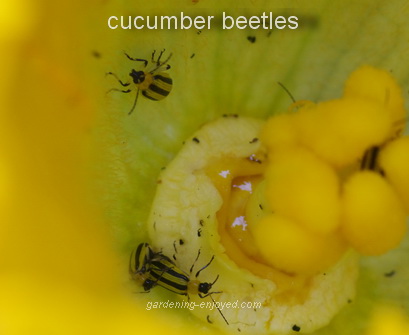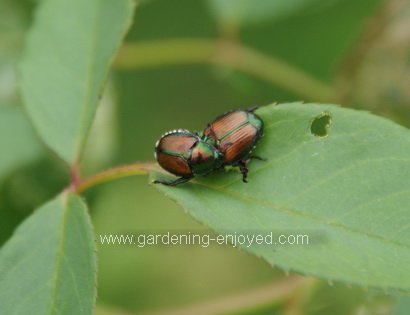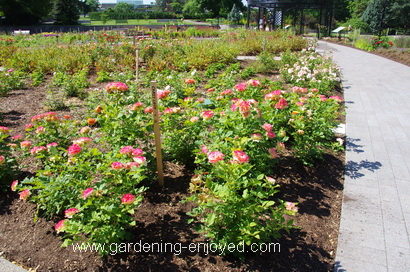| Back to Back Issues Page |
 |
|
Dallying In The Dirt, Issue #322 - The beetles have arrived and they don't play music. July 13, 2018 |
 The winter was not severe enough. Now, many dead plants would not agree with me. The dreaded Cucumber Beetle seemed to overwinter very nicely and has returned to my garden with a vengeance. Cucumbers, Zucchini, Melons, Squash they all share this beast. Not equally, it definitely has preferences and Cucumbers are not one of them although it can do terrible damage to them. My main method of attack is to go for a walk early in the morning. They like to spend the night deep inside the large flowers of Zucchini and I find them there and pump my insecticidal soap into that nice yellow trap. That seems to keep their numbers down to a manageable size allowing all of those crops to grow and produce. They also have a larval stage in the soil that loves to eat the roots of Cucumbers and that has been a problem in past years. My Cucumber vines would grow to a certain size and then just start to wilt as their roots were
attacked. This year my Cucumbers are growing in one of my subirrigation containers and as they are covered with a plastic much cover the soil is unavailable to these beasts and the vines, so far, are doing very well. The Zucchini are producing at a great rate and we have even had sufficient to sell a batch through Seed Voyage a great new concept you should check out.
The winter was not severe enough. Now, many dead plants would not agree with me. The dreaded Cucumber Beetle seemed to overwinter very nicely and has returned to my garden with a vengeance. Cucumbers, Zucchini, Melons, Squash they all share this beast. Not equally, it definitely has preferences and Cucumbers are not one of them although it can do terrible damage to them. My main method of attack is to go for a walk early in the morning. They like to spend the night deep inside the large flowers of Zucchini and I find them there and pump my insecticidal soap into that nice yellow trap. That seems to keep their numbers down to a manageable size allowing all of those crops to grow and produce. They also have a larval stage in the soil that loves to eat the roots of Cucumbers and that has been a problem in past years. My Cucumber vines would grow to a certain size and then just start to wilt as their roots were
attacked. This year my Cucumbers are growing in one of my subirrigation containers and as they are covered with a plastic much cover the soil is unavailable to these beasts and the vines, so far, are doing very well. The Zucchini are producing at a great rate and we have even had sufficient to sell a batch through Seed Voyage a great new concept you should check out. Cucmber beetles are relatively small and hard to catch but to make up for that this week I found a much larger invader. Japanese Beetles are attacking my Eggplant. I was deluding myself into thinking they would not be back this year. I have never seen them on the Eggpplant before so I went out and checked their favourite Rose and there they were. I chase them with my needle nosed pliers. They nice and large and easy to grab and they give such a satisfying crunch when you close those pliers on them. They are rather beautifully coloured but their ability to consume my plants quickly takes away any admiration I might have for them. There are traps that will catch them but those traps also attract the beetles from your neighbour’s yard. If you want to use traps offer to buy them and give them to your neighbours so your beetles will leave your yard and go to theirs.
Cucmber beetles are relatively small and hard to catch but to make up for that this week I found a much larger invader. Japanese Beetles are attacking my Eggplant. I was deluding myself into thinking they would not be back this year. I have never seen them on the Eggpplant before so I went out and checked their favourite Rose and there they were. I chase them with my needle nosed pliers. They nice and large and easy to grab and they give such a satisfying crunch when you close those pliers on them. They are rather beautifully coloured but their ability to consume my plants quickly takes away any admiration I might have for them. There are traps that will catch them but those traps also attract the beetles from your neighbour’s yard. If you want to use traps offer to buy them and give them to your neighbours so your beetles will leave your yard and go to theirs.Now it’s time to answer a few
of my reader’s questions. To ask a question just “reply” to this ezine. Don’t forget to check the front page of the Website for frequent short ideas for current gardening activities. Bob Asks? The last number of years the tomato plants I have been planting grow exceedingly tall, especially the cherry tomatoes and some extra large tomatoes. The plants do produce a high volume of tomatoes especially the red cherry tomatoes. Some plants will grow upwards of 9 to 10 ft. tall or more and I don't have stakes that long. I have not started fertilizing the plants this year but the fertilizer I use is 18-18-21 Someone suggested cutting off the top of the plant. If |I do this will it stop the upward growth and will it cause the plant to start growing side shoots. When is the best time to cut off the top and how much should I cut off? |
| Back to Back Issues Page |
